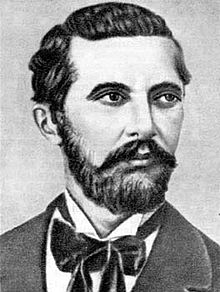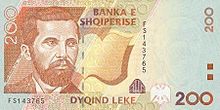Naim Frashëri
Naim Frashëri (born May 25, 1846 in Frashër , Ottoman Empire , today Albania , † October 20, 1900 in Kizil Toprak , Kadıköy , Ottoman Empire, today Turkey ) was an Albanian writer . For the Albanian national literature he is the most important author of the 19th century and the national movement Rilindja . It is still a popular classic to this day.
Life
Coming from the south of Albania, he received his first training at the Frashër-Tekke of the Bektashi order. In 1865 Frashëri's family moved to Ioannina ( Albanian Janina ) in Greece , where he and his younger brother Sami attended the Zosimea high school and graduated with success in 1869.
Naim Frashëri then entered the Ottoman civil service. In Istanbul in 1870 he worked for a few months in the printing office. A tuberculosis disease forced him to return from the big city on the Bosporus to the healthier climate of southern Albania. He worked first as a tax officer in Berat and then from 1872 to 1877 at customs in Saranda . During this time he wrote his first poems, which were also published from 1885. In addition to Albanian , Frashëri also wrote in Turkish , Persian and Greek . He also read French and Latin . He was one of the few men to whom the literary culture of the West and the Orient was equally familiar and valuable.
Returning to Istanbul, Frashëri became the most important author of the Albanian magazines Dituria (1884–85) and Drita (after 1885), which were published there by his brother Sami Frashëri. He wrote not only poetry, but also texts that were to be used for teaching in the first Albanian-speaking schools. The poet earned his living in the service of the Turkish Ministry of Education, whose commission for book printing (= censorship authority) he headed. Most of his books were published in Bucharest because printing in Albanian was not permitted in the Ottoman Empire at the time.
plant
Naim Frashëri devoted himself primarily to romantic poetry, which he designed according to classic patterns. His best-known work Bagëti e bujqësija (Animal husbandry and agriculture) is based on Virgil's Bukolika .
- Bagëti e bujqësi (Livestock and Agriculture) , 1886
- Luletë e verësë (The Flowers of Summer) , 1890
- Fletore e Bektashinjet , 1896 (Explanation of the Bektashi traditions)
- Istori 'e Skënderbeut (The Story of Skanderbeg ) , 1898
- Qerbelaja , 1898 (A poem about the battle of Karbala and the Imam Hussein )
Honors
The remains of Naim Frashëris and those of his brother Abdyl were transferred from Istanbul to Tirana in 1937 and buried in graves of honor. There are numerous monuments to the poet in Tirana and other Albanian cities; Statues also commemorate him in Bucharest.
A portrait of Naim Frashëri is printed on the front of the Albanian 200 lek banknote.
literature
- Enika Abazi, Albert Doja: Further considerations on the politics of religious discourse: Naim Frashëri and his Pantheism in the course of nineteenth-century Albanian nationalism. In: Middle Eastern Studies. Volume 49, No. 6, 2013, pp. 859-879. (English)
- Albert Doja: The Politics of Religious Dualism: Naim Frashëri and his elective affinity to religion in the course of 19th-century Albanian activism. In: Social Compass: International Review of Sociology of Religion. Volume 60, No. 1, 2013, pp. 115-133 ( online ). (English)
- Robert Elsie : The three Frashëri brothers. In: State Museum of Ethnology (Ed.): Albania. Wealth and diversity of ancient culture . Museum für Völkerkunde, Munich 2001, pp. 147–152 ( online , PDF file, 106 kB).
- Hasan Kaleshi: Frashëri, Naim . In: Biographical Lexicon on the History of Southeast Europe . Volume 1. Munich 1974, pp. 540-542
Web links
- Biography and a poem
- Works by Naim Frashëris : text, concordances, word lists and statistics (in English)
- Collection of poems (Albanian)
| personal data | |
|---|---|
| SURNAME | Frashëri, Naim |
| BRIEF DESCRIPTION | Albanian writer |
| DATE OF BIRTH | May 25, 1846 |
| PLACE OF BIRTH | Frashër |
| DATE OF DEATH | 20th October 1900 |
| Place of death | Kizil Toprak |

